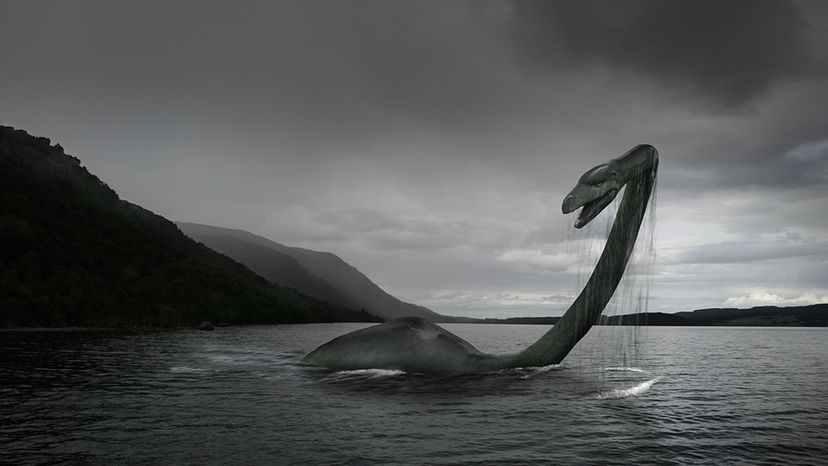
About This Quiz
Bigfoot who? Forget hairy bipeds, the Loch Ness Monster might actually be the world's most famous mythical creature. Or is it just a myth? Take our Loch Ness Monster quiz and find out!The creature has been reported by many sightings over decades in the highlands of Scotland. No word on whether the beast has that funky Scottish accent.
The Loch Ness Monster is often called simply "Nessie." Nessie is one of the most famous unseen creatures on the planet.
For decades scientists, skeptics and believers have all looked to prove or disprove Nessie's existence. No one really knows for sure if the creature is real.
Advertisement
"Loch" is a Scottish term for any large, landlocked body of water. Loch Ness is a 22-mile long lake in the Scottish Highlands.
Loch Ness is no ordinary lake. It is more than 22 miles long and in places, it is more than 1.5 miles wide. It's incredibly deep, too, with spots that go down as far as 750 feet.
Certainly, huge, long-necked dinosaurs have roamed the Earth. Scientists have uncovered their preserved fossils. Some people think that maybe Nessie is an isolated holdover from the dinosaur age.
Advertisement
Spicer and his wife were driving along when suddenly they spotted a long-necked, limbless creature with a large body crossing the road in front of them. Spicer estimated that the creature was perhaps 25 feet long.
Water-kelpies are water-horses, a magical type of animal from Scottish folklore. Some researchers believe water-kelpies are the origin of the myth driving Nessie.
It's a huge lake with all sorts of wildlife. But the bottom of the lake is very flat and doesn't provide much cover for large creatures.
Advertisement
In 1934, a British newspaper printed a now-iconic black-and-white picture of a long-necked object or creature on the surface of Loch Ness. The picture is still probably the most famous image associated with Nessie.
Wilson was a reputable doctor from London. He grabbed his camera just in time to quickly take four pictures before the creature disappeared. The image is often simply called the "surgeon's photo."
Wilson was reportedly happy to go along with many practical jokes, but he never admitted that his picture was faked. His good reputation in London anchored his claims as credible.
Advertisement
The biologist, Dennis Power, said he was sure the picture showed a swimming elephant. There are no elephants in Scotland of course, but Power said that he believed the picture was taken outside of the U.K.
Around 20 boats formed a line and set off down the length of the lake, blasting the water with sonar units. The crews noted a few minor anomalies but failed to document evidence of Nessie.
The Nessie phenomenon was mostly a 20th-century fad. There were a few sightings prior to the 1900s, but they were few and no more notable than others from around the world.
Advertisement
Marmaduke Wetherell made headlines by finding fresh footprints of the creature. A month later his claim was debunked when researchers pointed out that they were hippopotamus footprints.
Before the hoax, people jammed the roads to the loch in hopes of catching a glimpse of Nessie. After the claim was disproven, most people lost interest.
Rines was no dummy. He was a graduate of M.I.T. and created numerous inventions. After a trip to Scotland, he was intrigued by the mystery and decided to investigate for himself.
Advertisement
Rines took many sonar readings and lowered cameras into the depths. He captured several fascinating images, but none that conclusively proved the creature's presence in the lake.
Rines detailed how the number of Nessie sightings had dropped dramatically. He suspected that maybe the creature had gone extinct, perhaps in part due to global warming.
Scott decided to name the monster Nessiteras rhombopteryx, which means Ness monster with diamond-shaped fin. Suffice it to say, most scientists have not embraced his categorization.
Advertisement
Many people lost interest in the 40s and 50s, but a local author published a book regarding eyewitness accounts. The book inspired the Loch Ness Investigation Bureau, which started in the 1960s.
Google mounted a camera on a boat and took many pictures of the lake, its shoreline and even the depths below the surface. You can view the images using Google Street View.
Jeremy Wade, of "River Monsters," decided that the creature had to be a Greenland shark. These sharks can approach 20 feet in length and survive in very deep waters.
Advertisement
Unlike most creatures of legend, scientists really have made many serious attempts to find Nessie. After decades of intense searching, most reputable researchers no longer believe that the monster exists.
Believers say that there is possibly an underwater channel that allows creatures to swim from the lake to the sea. Perhaps Nessie left behind the lake for greener (bluer?) pastures.
Nessie is big business. Locals are happy to encourage the legend so long as tourists are willing to spend their money in the nearby town of Inverness.
Advertisement
In 2003, the BBC funded an expensive search for the creature. Teams used satellite tracking and hundreds of sonar beams in the making of the BBC documentary "Searching for the Loch Ness Monster."
Shiels was known as a psychic and magician, not the most credible background for a person claiming to see a mythical creature. In the 70s, he performed as the "Wizard of the West."
A prankster mutilated a large elephant seal and dumped it into the lake as part of a practical joke on the zoologists. Hoaxes like this are always uncovered, but they add to the legend's enduring mystique.
Advertisement